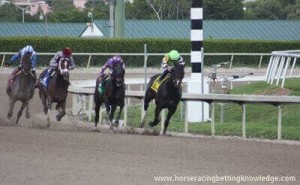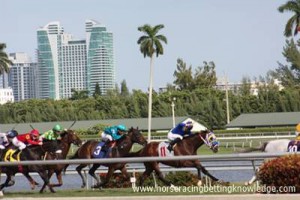Horse Racing Track Surfaces
What are the different types of Horse Racing Track Surfaces?
There are 3 different types Thoroughbred Horse Racing Track surfaces used today.
Dirt Track is usually the outer track and most common racing track surfaces in the US.
Turf Track is typically on the inside of the race track and most common racing track surfaces in Europe.
Synthetic (Polytrack) is a man-made surface that is only available at a certain of locations.
Dirt Track
Are the most common racing track surface in North America. Dirt Track surfaces are highly influenced by changes in weather.
fst = Fast Track – Footing at best, dry, fast and even.
gd = Good Track – Condition between fast and muddy.
wf = Wet Fast – Track that is wet on the surface but firm underneath.
my = Muddy Track – Deep condition of racetrack after being soaked with water.
sly = Sloppy – Condition of footing. Wet on the surface with a firm bottom. Usually, this indicates there is visible water on the surface.
sl = Slow – Footing that is not fast, between sloppy and heavy.
hy = Heavy – Condition of track similar, too, but even slower than muddy.
fr = FROZEN – Something that doesn’t happen often because if it’s dangerous for the horse’s and jockey races will be canceled.
Turf Course
For grass racing. Race Tracks in North America feature both a Dirt and Turf course, one outside of the other.
fm = Firm – A dry turf course with a slight give to it (corresponds with fast on a dirt surface).
gd = Good – A relatively firm turn course containing some moisture and slightly more give.
yl = Yielding – A very wet turf course that is deep and produces slower times.
sf = Soft – A turf course that contains a good amount of moisture and substantial give.
hy = Heavy – A deep, heavy and often waterlogged turf course that produces very slow times.
Synthetic Surface (Polytrack)
A man-made racing surface believed to reduce injuries to the horse and withstand weather changes. Used only at select tracks in California, Illinois, Kentucky, Pennsylvania and Canada.

How long is a Furlong in Horse Racing?
According to Wikipedia: The word “furlong” comes from Old English words furh (“furrow”) and lang (“long”). Originally it was the length of the furrow in one acre of a ploughed field. An acre is an area that is one furlong long and one chain wide. For this reason, the furlong was once also called an acre’s length. Around the year 1300, England standardized the furlong as 40 rods or 660 feet.
Thoroughbred Racetracks are measured in Furlongs, which 1 furlong equals to 1/8 of a mile or 220 yds. or 660 ft. Most tracks are 8 furlongs which equal to 1 mile which equals to 1,760 yds. and 5,280 ft.
Furlongs are marked on the track with poles.
Here are the furlong mile markers
1 furlong = 1/8 mile
2 furlongs = 1/4 mile
3 furlongs = 3/8 mile
4 furlongs = 1/2 mile
5 furlongs = 5/8 mile
5.5 furlongs = 11/16 mile
6 furlongs = 3/4 mile
6.5 furlongs = 13/16 mile
7 furlongs = 7/8 mile
7.5 furlongs = 15/16 mile
8 furlongs = 1 mile
8.5 furlongs = 1 1/16 miles
9 furlongs = 1 1/8 miles
9.5 furlongs = 1 3/16 miles
10 furlongs = 1 1/4 miles
10.5 furlongs = 1 5/16 miles
11 furlongs = 1 3/8 miles
11.5 furlongs = 1 7/6 miles
12 furlongs = 1 1/2 miles
If you are new to the Sport of Horse Racing Check out our Beginner’s Guide for Horse Racing!
CONTINUE READING: Horse Racing Running Styles
